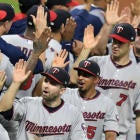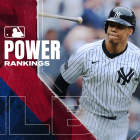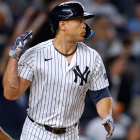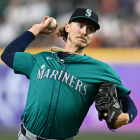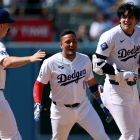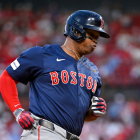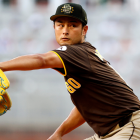The Twins fell to the Yankees in the AL Wild Card Game on Tuesday night in the Bronx, and that means their 2017 season has drawn to a close. That disappointment notwithstanding, the Twins have a lot of reasons to look back upon the campaign that was as a rousing success. Why's that? Well, two reasons come to mind ...
They got better. A lot better.
In 2016, the Twins lost 103 games -- their highest loss tally since they were the Washington Senators. This season, they improved by a hefty 26 games. Yes, they out-played their run differential by a couple of games, but on the run differential front they went from -167 in 2016 to +27 this year. That's big forward progress, to say the least. Along the way, they notched their first playoff berth since 2010.
The young talent base impressed.
Here's the big thing. The Twins are in the middle stages of a rebuild, so contention wasn't expected in 2017. It happened anyway. The good news in terms of maintaining that success is that young, controlled players contributed heavily to those successes. Consider ...
- Byron Buxton, after spending time over the offseason improving his first step, went from a very good defensive center fielder to probably the best defensive center fielder in the game today. As well, Buxton, who's still just 23, found his stroke in the second half and batted .300/.347/.546 after the break. He also was one of the best baserunners in the game, as he stole 29 bags in 30 attempts and took the extra base a highly impressive 71 percent of the time. He's once again looking like a future star.
- Miguel Sano took the next step. The third baseman dealt with injuries in 2017, but when healthy he put up big numbers: 127 OPS+ and 28 home runs in 114 games. What's promising in terms of Sano's future is the quality of contact he made. Sano this season had hard-hit rate of 44.8 percent versus a league-average mark of 31.8 percent. On the other end of the continuum, Sano had a soft-hit rate of just 13.5 percent versus a league-average figure of 18.9 percent. Those are impressive numbers. Also impressive is that Sano's average exit velocity off the bat of 92.4 mph ranked fourth in all of baseball. The guy can hit.
- Jose Berrios began to realize his potential. The 23-year-old right-hander made big strides in 2017 after putting awful numbers during his rookie season of 2016. This year he improved his K% (strikeouts as a percentage of batters faced) from 17.4 to 22.6 while more than halving his ERA. He also gives the Twins some above-average velocity and some swing-and-miss in the rotation, which is something they badly needed.
That's not all, of course. Shortstop prospect Nick Gordon will probably be an overall top-20 prospect going into 2018. The Twins spent the top overall pick of this year's draft on Royce Lewis, a hard-hitting shortstop with a full complement of tools. He'll likely remain at an up-the-middle position long-term. Lefty Stephen Gonsalves could force his way into the rotation early next season. Right-hander Fernando Romero gives the organization some mega-elite velocity. Also, 2015 first-rounder Tyler Jay will soon help the pitching staff in a role to be determined. That's just a sampling of the talent on the farm.
So far, so good for the new front office
For a long time under previous regimes, the Twins failed to blend traditional scouting with advanced analytics. That old-school approach went swimmingly for a long time, but it eventually became outmoded and costly to the organization. Early last offseason, though, the Twins brought in Derek Falvey from the Indians to serve as chief baseball officer, and Falvey subsequently hired Thad Levine away from the Rangers to fill the GM's role.
The new front office signed catcher Jason Castro last winter, which shows an acknowledgement of the value of pitch-framing these days. Then, after going for hitters with their top two picks of the June draft, they got creative with their slot budget to add some badly needed live arms in Landon Leach and Blayne Enlow. Then they pivoted leading up to the non-waiver deadline and added a few more interesting arms to the system. Particularly impressive was acquiring Jaime Garcia and then flipping him days later for a higher price in prospects.
The Twins for a long time pretty much ignored pitch-framing and emphasized pitching to contact with their arms. The latter approach became particularly costly in the current high-strikeout era when pitchers train for velocity and swings and misses. You can't restock a system's pitching stores in a single year, but the early returns are promising.
Looking ahead, some tough decisions will need to be made. Is it time to trade Brian Dozier after last winter's abundant rumors? Like Dozier, Joe Mauer is also heading into his walk year. Will the Twins make him a franchise lifer after a return to solid productivity in 2017? How will the front office build a bullpen befitting a contender? Will the young starters in the upper minors be able to help right away (the Twins need them to)? What's the outlook in a division that houses the mighty Indians and fast-rising White Sox? Those are all uncertainties. However, the Twins, coming off an impressive renaissance in 2017, have a young core than can carry them to relevance for years to come, and they have in place a front office capable of surrounding that core with contending talents.













